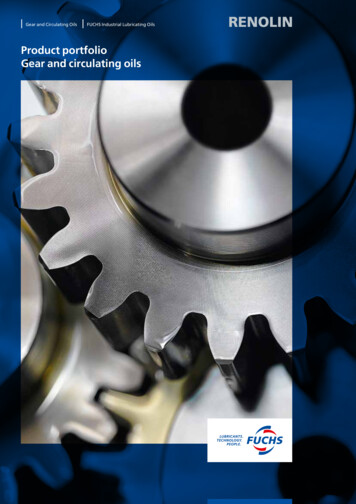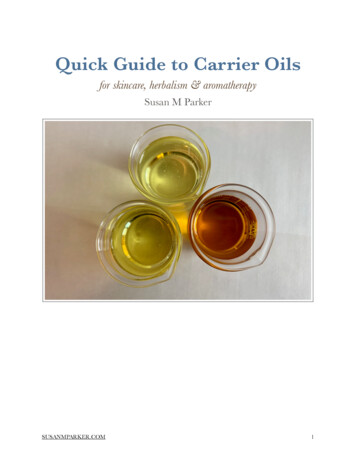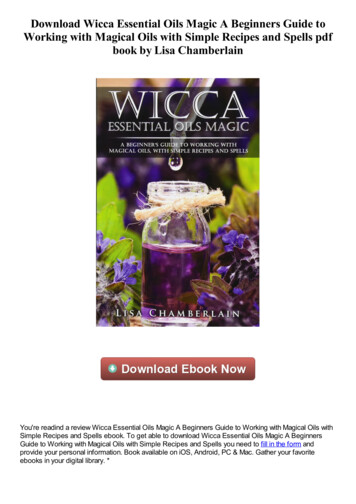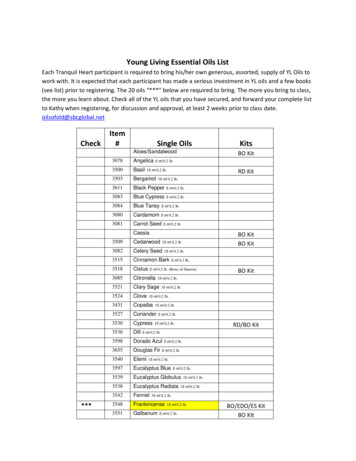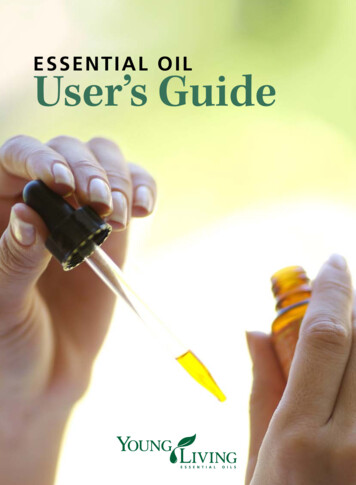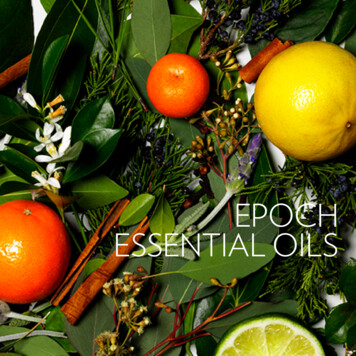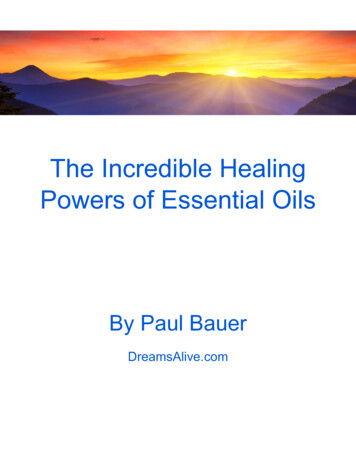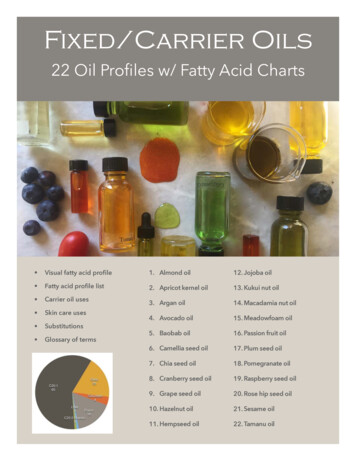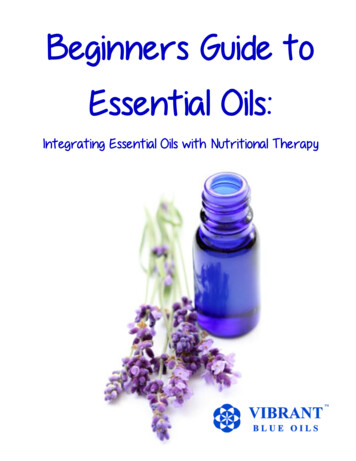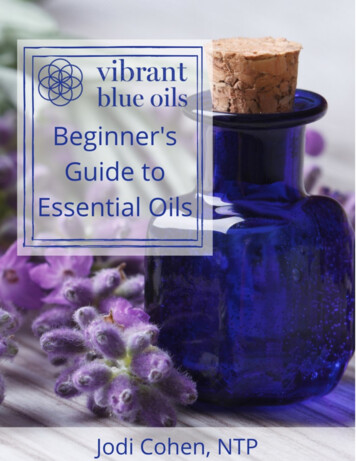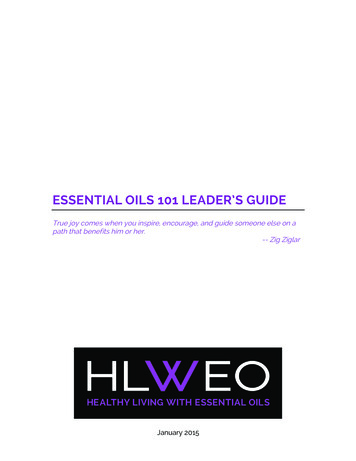
Transcription
ESSENTIAL OILS 101 LEADER’S GUIDETrue joy comes when you inspire, encourage, and guide someone else on apath that benefits him or her.-- Zig ZiglarJanuary 2015
You’re holding in your hands the most powerful tool you can use to build yourYoung Living business.As a Young Living business owner, you have the power to change people’s livesin ways they can’t imagine. Chances are, you’ve had some of those experiencesyourself, which is why you’re passionate about sharing with others.A major key to success in speaking about essential oils with others is this:Provide enough information about how to use essential oils to get peoplestarted, but avoid flooding them with so much information that it’soverwhelming.This is an important concept to keep in mind as you teach the 101 class.Whether you follow the Essential Oils 101 outline with 1 person or 30, theprocess and content are important to follow.Remember, the objective is to get someone started. It is not to overwhelm them.Class Format and SetupFrom the initial invitation, it’s important to set the right expectations. We alwayscall classes “classes” rather than “parties.”Classes have a specific format and people come with the expectation they’regoing to learn something new. In a “party,” it’s often more about eating, drinkingand visiting. The product is less of a focus than in a class.Seating: Don’t worry as much about how the seating structured. Most times, it’sin someone’s living room. Just be sure that your Everyday Oils are within armsreach as you lead the class.Music: Play some upbeat music. When the room is too quiet, it can beuncomfortable. With music playing, people tend to talk over the music. Theyspeak a little louder, and in doing so, the energy in the room goes up.Food and Drinks: Food and drinks can be a huge distraction before and duringthe class. Water, coffee, Slique tea can all be served. If you’d like to havesome dark chocolate or something similar that people could grab, feel free. TheSlique tea is a great way to introduce an extra product without needing to talkabout it during the class.Any additional food can be distracting, especially once you start to teach theclass. If you really want to have food, especially if the class is with some closefriends, wait until the end of class when people are enrolling to bring it out.Pen and Paper: Encourage people to bring a pen and paper with them to class,but be prepared for everyone who will forget. By having people take notes asyou teach, it helps them stay focused on the presentation.2
Class Materials: While teaching your class, the only thing your guests need is apiece of paper and pen to take notes. All other materials provide a distraction.Take-aways are just that — meant for the guest to take away with them toreview the information you shared with them during class.The “Why” Behind the ScriptWe created the following script based on the fact that in almost every case,when someone buys something, he or she goes through a certain process.There are a number of “sales” or “buying process” models, but an often-usedmodel comes from Brian Tracy. His 7 Steps to a Sale are the following:1.2.3.4.5.6.7.ProspectingBuilding RapportIdentifying NeedsDelivering a Persuasive PresentationHandling ObjectionsEnrolling New MembersGetting Repeat Sales and ReferralsSteps 2-6 apply to the class. Obviously, if people are in your class, you’ve takencare of step 1, and step 7 comes through strategic follow-up.Prospecting is a topic for a different guide or training. One of the best resourcesyou could read on building rapport and long-lasting relationships is DaleCarnegie’s How to Win Friends and Influence People.This book is more important than ever. We’ve veered away from face-to-face,personal communication in exchange for the efficiency of text messages, socialmedia and email. If you want the best chance of winning someone over to yourway of thinking, and get them to explore the benefits of essential oils, it’s alwaysbest to look them in the eyes and let them see, feel and hear your passion andenthusiasm.Building RapportWhen you’re teaching a class with people you know, it’s easy to overlook theimportance of building rapport. Not only is building rapport important forbreaking the ice and getting people to trust you, but this part of the presentationalso sets the tone for the class.Of course, welcoming people as they arrive is important.Identifying NeedsThe script is designed to help people understand the needs they have related toessential oils and the other products we carry with Young Living. Throughout thepresentation, they’ll see how many ways we’re exposed to toxins, how manyneeds they have that essential oils can solve, and why the oils they’ve bought in3
the past are the wrong choice. By simply informing people, they come to realizethat their environment isn’t as safe or healthy as they might have thought it was.Delivering a Persuasive PresentationThe intent of the script is to help you deliver a persuasive presentation. As timegoes on, and you use the script multiple times, your confidence in thepresentation will grow. Then, not only will the words that you are saying be moremeaningful, the way you say them will be more powerful as well. This is whyteaching many classes is so important.Handling ObjectionsIn most cases, if you have people who are qualified (you’re not presenting tokids without jobs), or if you follow the script with confidence, you’ll have alimited number of objections to enrolling.If you keep getting the same objections from people, there might be somethingyou are saying, or even a tone you might take in certain parts of the presentationthat could be leading people to those objections. Every once in a while, it’s agood idea to record your presentation and listen to it. You’ll realize that you saythings you had no idea you said.Enrolling New MembersYou’ll notice throughout the script that it mentions “enrolling at the end ofclass.” This is intentional. Whenever possible, we want people to enroll on thespot. If they wait and “think about it,” they probably won’t think about it. We justhave too much going on in our lives. Instead, they’ll forget about it. When youcheck in with them a week later, they remember very little about why they wereplanning to enroll. There are always exceptions to this, though. Some peoplereally will think about it, but these are the exceptions, rather than the rule.If they really want to think about whether or not essential oils should be part oftheir lifestyle, the best way to do that is to order the Premium Starter Kit and useit. If they find that they really don’t like essential oils at the end of 30 days, theycould return it. Of course, the chance of that happening is very small.4
Using the Two ScriptsThe rest of this guide contains two scripts. The first script is a combination ofthe script you say, and the “why” behind what you’re saying. What you say is inbold italics, the “why” is in grey.The first script is for you to use and study. It is to help you understand whyyou’re saying what you’re saying. We don’t want people to just say somethingfor the sake of saying something. You won’t have the same conviction, and youmay end up adding extra filler stuff or fluff. This adds extra time to the class andcan reduce the attention people have, and their excitement for enrolling.If you start by following the script as-is, and pay attention to how peoplerespond over time, you’ll learn to make minor tweaks to make it your own.Before you get to that point, it’s best to become totally comfortable with thescript as-is.I hope this resource helps you succeed with Young Living in whatever way youdefine success. As you know, there is so much power in what essential oils cando.“You can have everything you want in life if you just help enough other peopleget what they want.” Zig ZiglarJust about everyone wants to be healthier and happier. And many people wantto be better off financially. We can help lead them to health, happiness and abetter financial future.In Health & With Gratitude,Vanessa Romero651-206-4794vanessa@hlweo.comwww.hlweo.com5
ESSENTIAL OILS 101 SCRIPT – WITHEXPLANATIONLet me grab my cell phone quick and turn off the sound. I’d beembarrassed if it went off in the middle of class.This is a “hint” to everyone else to silence their cell phones and put them awaywithout telling them to do so.IntroductionOk, let’s get started. I’m so excited to have all of you here. My name is.I got started with Young Living .This next section really sets the stage to show people you’re “for real.” You’regoing to explain your “why” for being committed to Young Living. There are 3parts to your why. Take time to develop this and repeat it over and over. Notonly will it help others see how passionate you are, it will also help youremember why you started every time you tell the story.When I got started with Young Living, I was Explain the frustrations you were facing or what turned you onto essential oils.Were you looking for something to improve your health? Were you alreadyhealthy and trying to get healthier? Did you realize there was an incomeopportunity in an area (health) that you were already interested in? There can bemore than one reason but what was it that first got you to go to a class or meetwith someone to look at the essential oils? Share this. This will help people seethe emotion behind why you listened to someone talk about the oils the firsttime. Many people will put themselves in your shoes at that moment.When I was introduced to Young Living, I saw What was it that made you say yes? Why did you give into trying the oils andpursuing the business? Again, some people will see themselves in yourexample. Others will just simply see that you made a very logical decision basedon where you were and why you decided to enroll. When they see that it madesense for you, they’ll start thinking that enrolling would make sense for them.Now that I’ve been with the company for , my goal is to Share your vision for what you hope to do with the business. Share your goal forhow many people you want to enroll with the oils. Share a vision for what you’dlike to do WITH the people who enroll, so they can see that they’re in for anexciting adventure, they’re not just signing up to order some products.6
Before we get started, I need to mention this disclaimer: The information intoday’s class is not intended for the treatment or prevention of disease noras a substitute for medical treatment, nor as an alternative to medicaladvice. To practice medicine requires a license. To educate about healthdoes not. Today’s class is for educational purposes only.You should say this with a little bit of a smile. Everyone knows you’re not adoctor. Most people today also understand that doctors don’t have all theanswers and that there is value in improving health by natural means.Our goal in the next hour and a half is to help each of you betterunderstand the value of Young Living Essential Oils and how you can easilyget started using them. You will notice I am holding a script today. This isto insure we stay on track with all the information I have to share. Also,when you enroll with Young Living, I know you will want to share with yourfriends and family and all you need is the script.You’re setting the expectation that you plan to stay on track with the time andalso showing how easy it is to teach a class using the script. This will help youavoid tangents or having people take you too far off the script later on. Asquestions come up, you can always say “That’s a great question. Let’s hold itfor the end so I can make sure we finish on time, so we can get people enrolledand on with their day. I can stick around answering questions for as long as weneed to, though.” This repeats that you’re staying on a schedule, and alsoreminds people that they’ll be enrolling at the end.I’m going to spend some time on how essential oils are made and used,and show you the most common oils people use on a daily basis. I do thisas a part-time/full-time job, and I’m always looking to help others who areinterested in making some extra money. I’m not going to spend time on thebusiness side of Young Living tonight, but after getting enrolled, I’ll set upa one-on-one meeting with anyone who is interested in the business side.Other than a brief introduction, you’re also “teasing” the business opportunity.Essential Oils BasicsWhat are essential oils?When I first learned about essential oils, I thought they were just goodsmelling products found at Whole Foods or natural foods stores. I justdidn’t know much about them. I didn’t realize that they’re a lot more than“natural perfume.”By admitting that you didn’t know anything when you got started, you’re againshowing them that you were once in the same spot as they were. This helpsbuild more trust.7
Speaking of “natural perfume” or “fragrances,” candles are more popularthan ever. Most candles emit all sorts of toxins, though. There’s evidencethey can even contribute to asthma.Some people have taken a first step in using essential oils just to get rid oftheir toxic candles and air fresheners.Right away, you’ve caught the attention of some people who probably have abunch of candles and air fresheners in their home. You’ve created one of anumber of “problems” in people’s minds that essential oils can solve.Essential oils are actually the lifeblood of the plant. Just as you havethousands of different types of molecules floating in your blood stream,plants have thousands of different constituents flowing through them tosustain life as well.Pretty self-explanatoryEssential oil is found throughout the plant—the leaves, stems, branches,bark and other woody parts. The oils are extracted from some or all ofthese parts of the plant based on the type of oil we’re talking about.DistillationWhen essential oils are extracted properly, we can gain numerous healthbenefits from their use. It’s key, though, that the oils are extractedproperly.Most therapeutic-grade oils are steam distilled, at as low a temperature aspossible, to extract the majority of the oil in the plant. An exception wouldbe citrus oils, which are cold-pressed from the rind. Commercial oils orperfume-grade oils like you find at Whole Foods are often distilled at highertemperatures for shorter periods of time using chemical solvents instead ofsteam. This degrades the therapeutic parts of the oil while maintaining thescent. In this way, an essential oil can be produced much faster andcheaper, but this also creates confusion. People think of all essential oilsas the same, but they’re not. If they’re not distilled properly, they don’tdeliver the health benefits we talk about.It’s important to bring up the quality difference and reference other placespeople will see oils. It’s easy to assume that “if it’s at Whole Foods it’s greatquality.” That’s not always the case.This is one area where Young Living stands out from other essential oilbrands. We own ten farms all over the world—in Utah, Idaho, Canada,France, Oman, Ecuador, Peru and Croatia. This gives Young Living anadvantage in that we have control of the process from the planting of theseed to sealing the finished product. It’s Young Living’s Seed to Sealpromise.8
Some oils are acquired, with very careful scrutiny, from partner or co-opfarms, but even in these cases, Young Living maintains the higheststandards for quality from seed to seal of any essential oil company.The reason this is so important is that only 100% pure essential oils shouldbe used therapeutically. You don’t want to be ingesting, inhaling or evenputting on your skin, oils that contain chemicals, solvents, or otheradulterations.As a side note, a number of chemicals are considered “organic” becausethey’re made from naturally-occurring molecules, yet they are harmful tohumans. “Organic” does not always mean “healthy.”For anyone who as already looked at oils, you’re handling a quality and priceissue before they can bring it up. Some people may even have oils in their homethat they ordered from a retail store or pharmacy. You’ve now planted a seed inthe back of their mind, suggesting that they really shouldn’t be using thatproduct.Using Essential OilsEssential oils are typically used three ways. There are others, but they aremore for the experienced user.Note: Don’t get off track by all of the other ways oils are used. If peopleunderstand these three, it’s enough. As they become regular users, they’ll startto learn of the other methods of use.First, essential oils can be inhaled. Inhalation can take place by simplyputting oils on your hands and inhaling. I’m going to pass around thepeppermint. What I want you to do is put one drop in the palm of yourhand. Bring your hands together and rub them in clockwise circles threetimes. Based on the structure of essential oils, this helps activate the oils.Then, you’re going to cup your hands over your face, without touching youreyes, and take a few, long, deep breaths.Pass around the peppermint and let everyone give it a try. In doing so, they’llexperience something really enjoyable and you’ll also increase their level ofattention.Take a few minutes for the bottle to go around and people to try it out. Let themcomment about what they think.When you start using your oils, you’ll be using your diffuser a lot. We dotoo. Our diffuser is running for the majority of the day, whether we are athome, or at the office, and we also run the diffuser at night in our bedroomwhen we go to sleep.9
These words are very specific. You’re painting the picture of them using theirdiffuser and enjoying the oils. You’re also explaining that the diffuser is going toget a lot of use. Obviously, when it comes time to enroll, you need a diffuser (ortwo).Like the essential oils, diffusers vary in quality as well. The diffusers weoffer through Young Living are ultrasonic. They vibrate in a way that helpsdiffuse the oils most effectively. You should always be careful of thediffusers you purchase, as some of them may not properly diffuse the oils.If someone has a diffuser already, you’ve explained why they need one from YL.If they don’t have a diffuser, you have explained why they need to get one fromYL.When the oils are diffused, the oil particles enter and hang in the air. Asyou breathe in the oil particles, they stimulate your olfactory nerves, thenerves in your nose. They can also enter the lungs and then enter theblood stream. This is because oil particles are so small. When you inhaleYoung Living’s essential oils, you’re actually getting them into your bloodstream. That’s pretty cool!For those who were thinking essential oils were just about the scent, you’veexplained why there is a scientific reason they’d deliver a therapeutic effect,rather than just offering a pleasant smell.The second way essential oils are used is by applying them topically.Depending on your goal for the use of the oil, they can be applied on soremuscles, over specific organs, on your neck, or they can be applied to yourfeet.Oils are absorbed especially well through the bottoms of your feet. Again,because the actual oil particles are so small, they can easily be absorbedthrough the skin.Some oils are considered “hot” because they are hot on the skin, andshould be diluted with a carrier oil. A carrier oil, like avocado oil, coconutoil, or this V-6 (point to your bottle of V-6 if you have it), helps to spread theoil over a larger area, slows the absorption of the oil, and lightens the“heat” of a hot oil.For example, peppermint has a recommendation of 4 drops of carrier oil foreach drop of peppermint. The dilution recommendations are a place tostart. You may find that you don’t need as much oil for dilution as youthought, once you get started. If you have sensitive skin, though, you mayneed a little more dilution.Many oils can be applied “neat” which means they do not need to bediluted. The label will show if you can or should apply it “neat,” as will yourEssential Oils Pocket Reference Guide.10
This section should be self-explanatory. It’s important to explain that some oilsneed to be diluted so people aren’t surprised by the hot oils. By againreferencing the EOPR, you’re planting the seed for the close.As an example, I apply on a regular basis for .Give an example of an oil or two from the PSK that you apply topically when youneed it. This helps make it real.The third way essential oils are used is by ingesting them as supplements.This is common in the way they’re used in France, but less common inGreat Britain and the United States.Important to note in the event someone has been told in the past that theyshould never ingest essential oils.The reason ingestion is less frequently recommended here, is that mostavailable oils are not pure essential oils. They are altered, adulterated andmay be partially or completely synthetic.This reiterates our product quality and reminds them that you can’t use thesame recommendations for use of retail essential oils as YL essential oils.You’ll see on the label the oils that can be used as a supplement. In thiscase, they can be added to water, like lemon, or dropped into a capsule,like I do with (example of oils you use in capsules).Peel back the label on your bottle of lemon and show the supplements factslabel. Like above, providing a personal example makes it real.DiGize is a super-popular blend that is often taken in capsule form to helpwith digestive issues. It’s one of our most popular essential oils outside ofour Everyday Oils collection.Dropping the name of another oil beyond what’s in the Everyday Oils collectionsets up the opportunity to add onto the PSK when they enroll.Everyday OilsOk, now we’ll cover what we call the 10 “Everyday Oils.” These are kind oflike having salt, pepper and butter in your kitchen. You use thoseingredients in a number of different ways in any given week. The samecould be said of these 10 essential oils. They serve a lot of purposes. Wealways recommend these 10 everyday essential oils as the foundation ofyour essential oil collection.Most people keep butter, salt and pepper stocked in their kitchen, even if theywon’t need them right away. This analogy helps people understand that even ifthey don’t see an immediate need for some of the oils you’ll cover in the11
Everyday Oils collection, they will probably need them at some point, so it’s agood idea to have them on hand.We have more than 100 other essential oils that can serve more specificpurposes as well. I’m not going to get into those today as we don’t havetime, and it can be way too overwhelming. However, when you enroll, if youfeel there are a couple other specific needs you have, we can talk aboutwhat additional oils would be wise to add to your order.As was the case earlier, we’re making an assumption people are going to enroll.For the person who wasn’t considering enrolling earlier, they may feel at thispoint that everyone else is, which will make them feel better about enrollingthemselves as well.There is an adage that goes along with this idea: No one wants to be first, last orleft out. If most other people seem to be enrolling, others feel better about doingso.The first five essential oils we will cover are called “single” oils—theycontain just one essential oil. After that, we will talk about the “blends.”Blends are made by combining singles. The information about each ofthese oils comes from the Essential Oils Pocket Reference (hold it up toshow). This is something you will receive as a gift when you enroll at theend of class.We reference that the benefits of the oils come from the EOPR so we have a textas a reference, and so they know they don’t have to remember everything.When they enroll, you’ll give them the guide, so they have that awesomeresource.1. Lavender (Pass the bottle of lavender around for people to smell it)Lavender is one of the most commonly-used essential oils. It’s also one ofthe most adulterated, so if you ever have the thought of buying a retailversion of lavender, be careful.You can’t reiterate enough that the oils found at the store are nowhere near thequality you’ll find through Young Living. When people hear this enough, theynever come back with the “it’s too expensive” objection.You can soothe minor burns by applying 2–3 drops of lavender essential oilto the affected area. It also helps with dry or chapped skin.Add a few drops of lavender essential oil to a cotton ball and place it in acloset or drawer to scent linens and repel moths and insects.Applying it topically may minimize the appearance of scar tissue.Place a few drops of lavender essential oil on a wet cloth or dryer ball todeodorize and freshen your laundry.12
Diffusing lavender essential oil can minimize seasonal discomforts.Diffusing helps calm the mind, body and spirit and can help with sleep.Rubbing it on your pillow helps as well.I use lavender for With each of the oils, keep your list of uses long enough to help people see whythey’d need the oils, but short enough that you stay on track with your timeline.Share a few examples of how you or someone in your family uses lavender, buttry to avoid having a bunch of people chime in with their own uses as well. If youspend too much time with people sharing their uses of the oils, you’ll go far toolong with the presentation.2. Melaleuca Alternifolia (Pass bottle around)Also known as “tea tree oil,” melaleuca is often used for purifying anddisinfecting. Melaleuca essential oil has been found to digest bacteria,viruses and fungus. It also is great at supporting the immune system.Melaleuca is used for fungal infections like athlete’s foot, yellow toenailsand other stuff you might get from a gym floor or a pedicure. It’s helpful forother skin issues like acne as well as cold sores.Melaleuca also is used as a natural deodorant.Diffusing melaleuca helps purify the air.I use melaleuca for 3. Lemon (Pass bottle around)Lemon and other citrus fruits are not steam distilled. Instead, these oils arecold-pressed from the rind.Lemon is a “natural” goo-gone. It helps remove grease spots from clothes,adhesives, and other stuff like crayons.You can combine 2-3 drops with water in a spray bottle to naturally cleanseand sanitize.A drop of lemon helps with oily skin, soothes calluses, bunions or otherskin irritations.Massaging lemon on cellulite helps improve circulation and eliminateswaste from cells.Lemon essential oil has been widely used in skin care to cleanse skin,reduce wrinkles, and combat acne.13
A compound found in citrus oil, called d-limonene has been extensivelystudied for its ability to aid our body’s natural detoxification process. It’s agreat oil to add to drinking water to support the body’s detoxificationprocess. A lot of detox programs suggest drinking lemon juice, but thejuice has very little, if any d-limonene. It’s found in the rind, not in the fruit.The fragrant influence of lemon, along with other citrus oils like grapefruit,lime, orange, is mood boosting.I use lemon for 4. Frankincense (Pass bottle around)You may know Frankincense from Bible stories. It was one of the mostprized oils of biblical times, and still is today. Frankincense is mentioned inone of the oldest known medical records, dating from the 16th century, withmore than 877 uses.Frankincense is also a commonly adulterated essential oil. For every poundof frankincense essential oil that is made in the world, 12 pounds are sold.That means there’s a lot of “fake frank” on the shelves of stores.Rubbing frankincense on your temples and back can improveconcentration. It can help with blisters and insect bites.Diffusing Frankincense can elevate your mood and rubbing it on stretchmarks may help lessen their visibility.I use Frankincense for 5. Peppermint (already passed around)Peppermint is the last “single” oil from our Everyday Oils collection. This isanother essential oil where you’ll find a number of “imposters.” It maysmell like peppermint, but is really created just for the fragrance or taste.Young Living’s peppermint essential oil is so potent that just one dropdelivers the effectiveness of 26 cups of peppermint tea.A University of Cincinnati study found that inhaling peppermint oilincreased mental accuracy by 28%. Inhaling peppermint has also beenshown to curb appetite. In fact, research has shown that simply inhalingpeppermint oil throughout the day has led to weight loss compared tothose who didn’t smell the peppermint oil.Peppermint is soothing on the digestive system and cooling for the body.You can add one drop to a water bottle to soothe an uncomfortablestomach or to help keep the body cool during exercise.14
Peppermint is soothing to tight muscles and invigorating when appliedtopically. You may need to dilute with a carrier oil if you have sensitive skinor don’t like the “hot” feeling of the peppermint.I use peppermint for The next five oils from the Everyday Oils collection are all blends. D. GaryYoung, the founder of Young Living, is a master at blending essential oils.The intent of an oil blend is to look at the constituents of individual oils,and blend them together to create a synergistic effect you wouldn’t havefrom any one of them alone.6. Thieves (Pass bottle around)Thieves is amazing for keeping you feeling good when everyone elsearound you seems to be getting sick. You can diffuse Thieves, apply it toyour feet or take it internally for an immune boost.A Weber State University study showed a 99.6% reduction in airborneviruses and bacteria when diffusing Thieves.This oil is so popular that Young Living has a whole line of Thievesproducts using the oil blend—toothpaste, mouthwash, hand soap, breathmints and more.Thieves supports the immune system, can help maintain normal bloodsugar levels, obviously helps maintain health and has a fantastic spicyscent when diffusing. It helps clean the air witho
Provide enough information about how to use essential oils to get people started, but avoid flooding them with so much information that it’s overwhelming. This is an important concept to keep in mind as you teach the 101 class. Whether you follow the Essential Oils 101 outline with 1 perso
